Motivation in Employees: HR Strategies and Theoretical Analysis
VerifiedAdded on 2022/08/26
|8
|1658
|28
Report
AI Summary
This report provides an analysis of employee motivation from an HR practitioner's perspective, covering intrinsic and extrinsic motivation, and major theories such as Maslow's hierarchy of needs, Herzberg's two-factor theory, and Vroom's expectancy theory. It highlights the importance of motivation in enhancing employee productivity and job satisfaction. The report includes recommendations for HR managers to motivate employees through appreciation, incentives, positive work environments, and transparent policies. The conclusion emphasizes that motivated employees contribute to improved work quality and organizational success, underscoring the critical role of effective human resource management in leveraging HRM strategies to foster a motivated workforce.
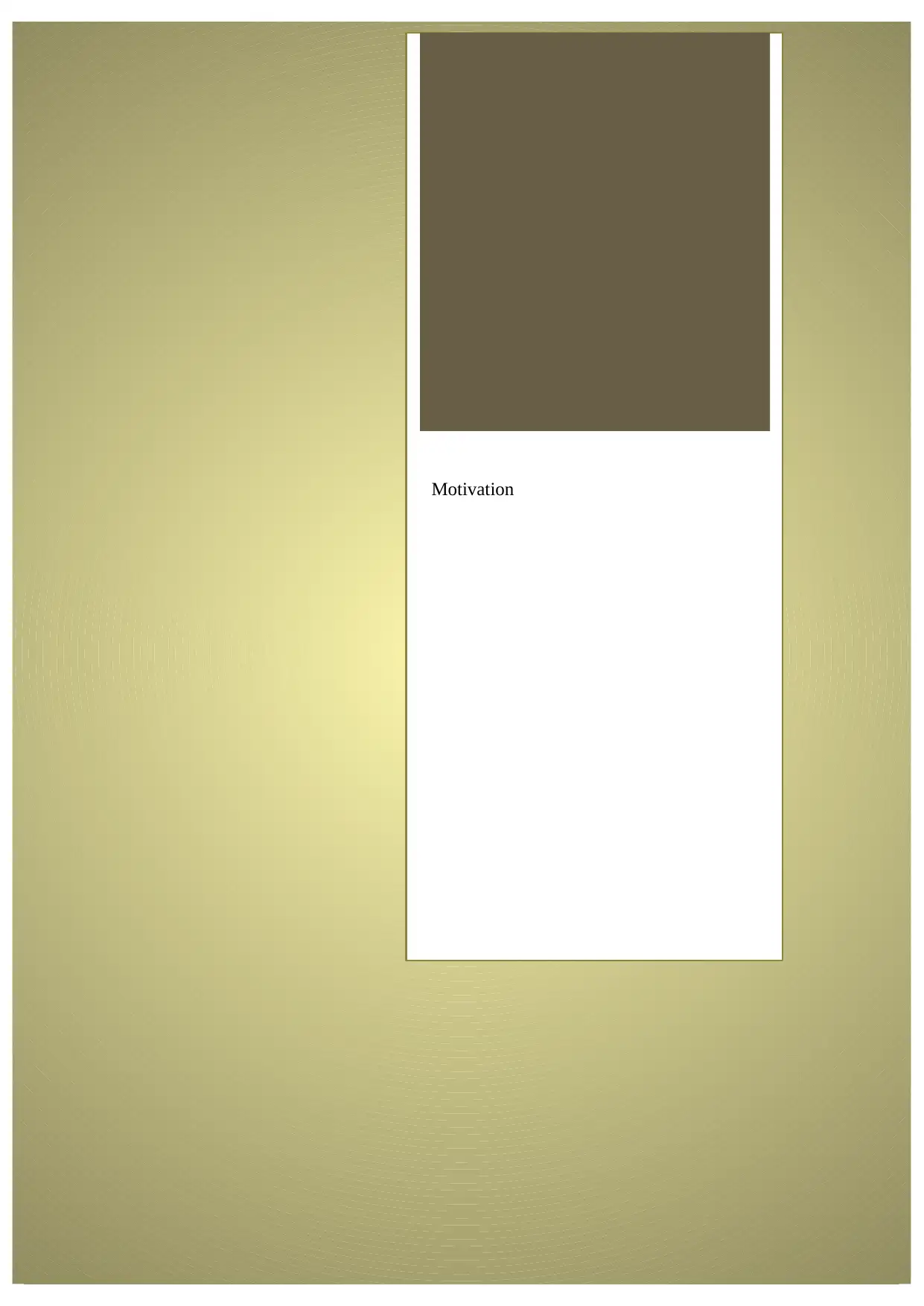
Motivation
Paraphrase This Document
Need a fresh take? Get an instant paraphrase of this document with our AI Paraphraser
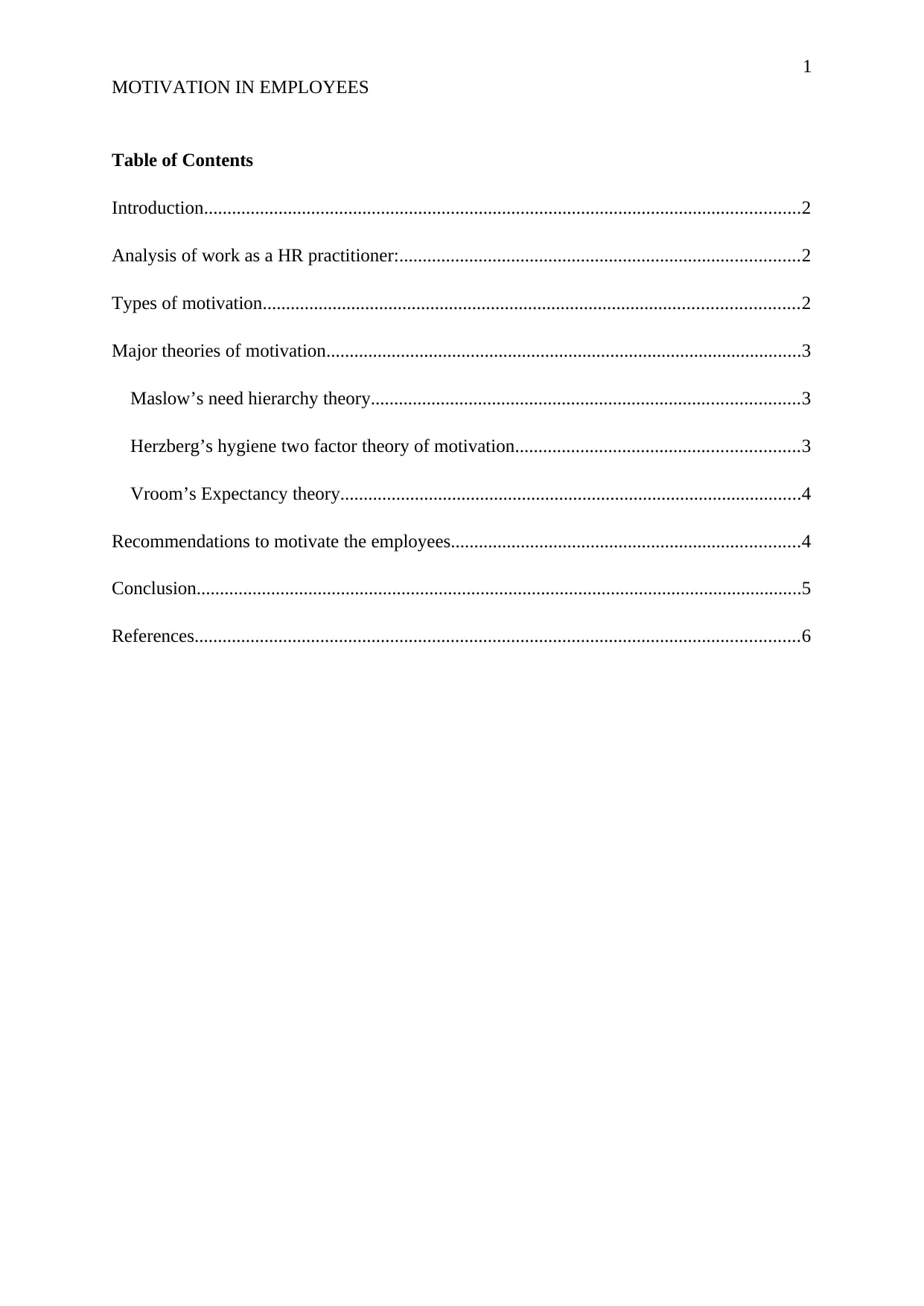
1
MOTIVATION IN EMPLOYEES
Table of Contents
Introduction................................................................................................................................2
Analysis of work as a HR practitioner:......................................................................................2
Types of motivation...................................................................................................................2
Major theories of motivation......................................................................................................3
Maslow’s need hierarchy theory............................................................................................3
Herzberg’s hygiene two factor theory of motivation.............................................................3
Vroom’s Expectancy theory...................................................................................................4
Recommendations to motivate the employees...........................................................................4
Conclusion..................................................................................................................................5
References..................................................................................................................................6
MOTIVATION IN EMPLOYEES
Table of Contents
Introduction................................................................................................................................2
Analysis of work as a HR practitioner:......................................................................................2
Types of motivation...................................................................................................................2
Major theories of motivation......................................................................................................3
Maslow’s need hierarchy theory............................................................................................3
Herzberg’s hygiene two factor theory of motivation.............................................................3
Vroom’s Expectancy theory...................................................................................................4
Recommendations to motivate the employees...........................................................................4
Conclusion..................................................................................................................................5
References..................................................................................................................................6
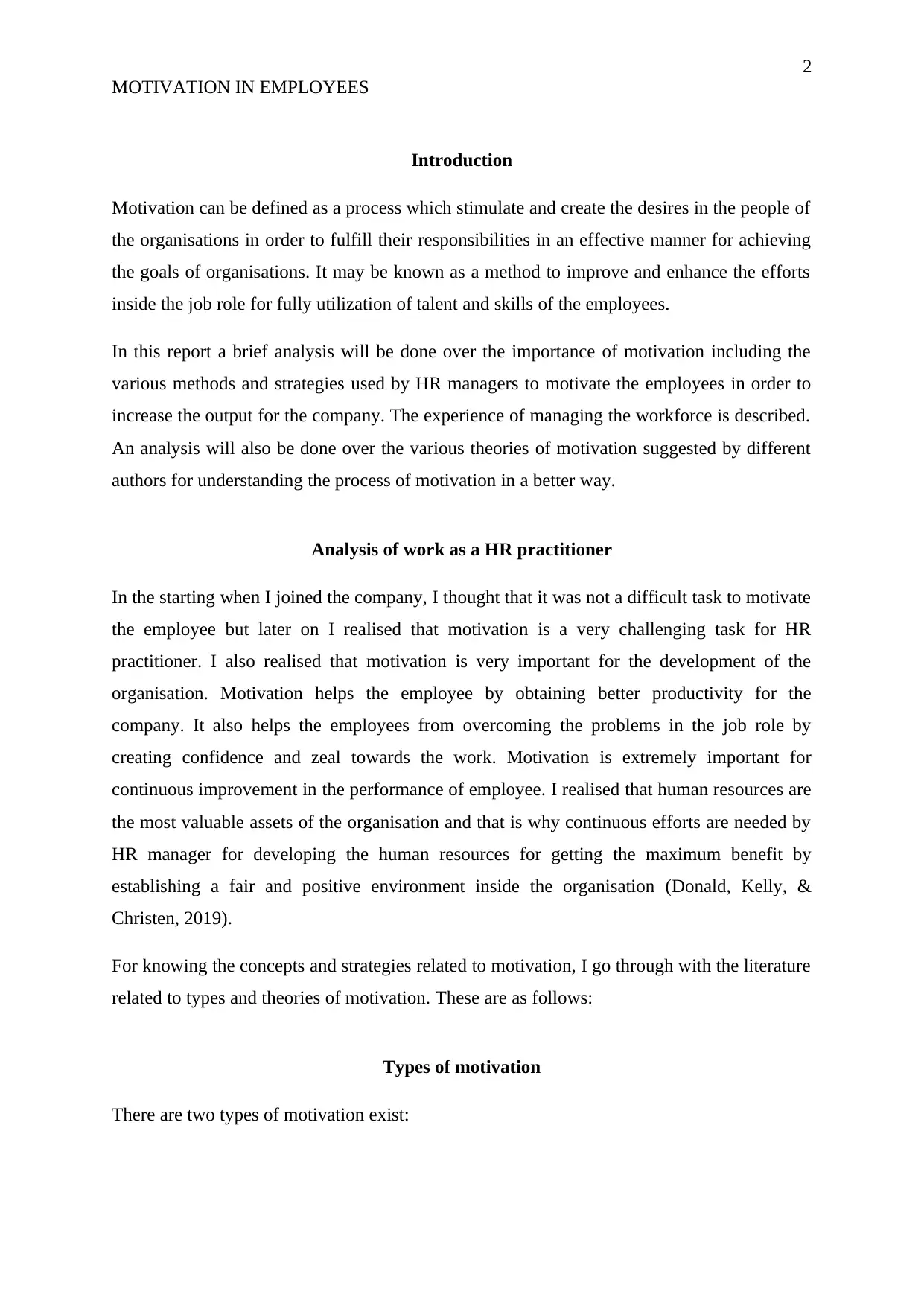
2
MOTIVATION IN EMPLOYEES
Introduction
Motivation can be defined as a process which stimulate and create the desires in the people of
the organisations in order to fulfill their responsibilities in an effective manner for achieving
the goals of organisations. It may be known as a method to improve and enhance the efforts
inside the job role for fully utilization of talent and skills of the employees.
In this report a brief analysis will be done over the importance of motivation including the
various methods and strategies used by HR managers to motivate the employees in order to
increase the output for the company. The experience of managing the workforce is described.
An analysis will also be done over the various theories of motivation suggested by different
authors for understanding the process of motivation in a better way.
Analysis of work as a HR practitioner
In the starting when I joined the company, I thought that it was not a difficult task to motivate
the employee but later on I realised that motivation is a very challenging task for HR
practitioner. I also realised that motivation is very important for the development of the
organisation. Motivation helps the employee by obtaining better productivity for the
company. It also helps the employees from overcoming the problems in the job role by
creating confidence and zeal towards the work. Motivation is extremely important for
continuous improvement in the performance of employee. I realised that human resources are
the most valuable assets of the organisation and that is why continuous efforts are needed by
HR manager for developing the human resources for getting the maximum benefit by
establishing a fair and positive environment inside the organisation (Donald, Kelly, &
Christen, 2019).
For knowing the concepts and strategies related to motivation, I go through with the literature
related to types and theories of motivation. These are as follows:
Types of motivation
There are two types of motivation exist:
MOTIVATION IN EMPLOYEES
Introduction
Motivation can be defined as a process which stimulate and create the desires in the people of
the organisations in order to fulfill their responsibilities in an effective manner for achieving
the goals of organisations. It may be known as a method to improve and enhance the efforts
inside the job role for fully utilization of talent and skills of the employees.
In this report a brief analysis will be done over the importance of motivation including the
various methods and strategies used by HR managers to motivate the employees in order to
increase the output for the company. The experience of managing the workforce is described.
An analysis will also be done over the various theories of motivation suggested by different
authors for understanding the process of motivation in a better way.
Analysis of work as a HR practitioner
In the starting when I joined the company, I thought that it was not a difficult task to motivate
the employee but later on I realised that motivation is a very challenging task for HR
practitioner. I also realised that motivation is very important for the development of the
organisation. Motivation helps the employee by obtaining better productivity for the
company. It also helps the employees from overcoming the problems in the job role by
creating confidence and zeal towards the work. Motivation is extremely important for
continuous improvement in the performance of employee. I realised that human resources are
the most valuable assets of the organisation and that is why continuous efforts are needed by
HR manager for developing the human resources for getting the maximum benefit by
establishing a fair and positive environment inside the organisation (Donald, Kelly, &
Christen, 2019).
For knowing the concepts and strategies related to motivation, I go through with the literature
related to types and theories of motivation. These are as follows:
Types of motivation
There are two types of motivation exist:
⊘ This is a preview!⊘
Do you want full access?
Subscribe today to unlock all pages.

Trusted by 1+ million students worldwide
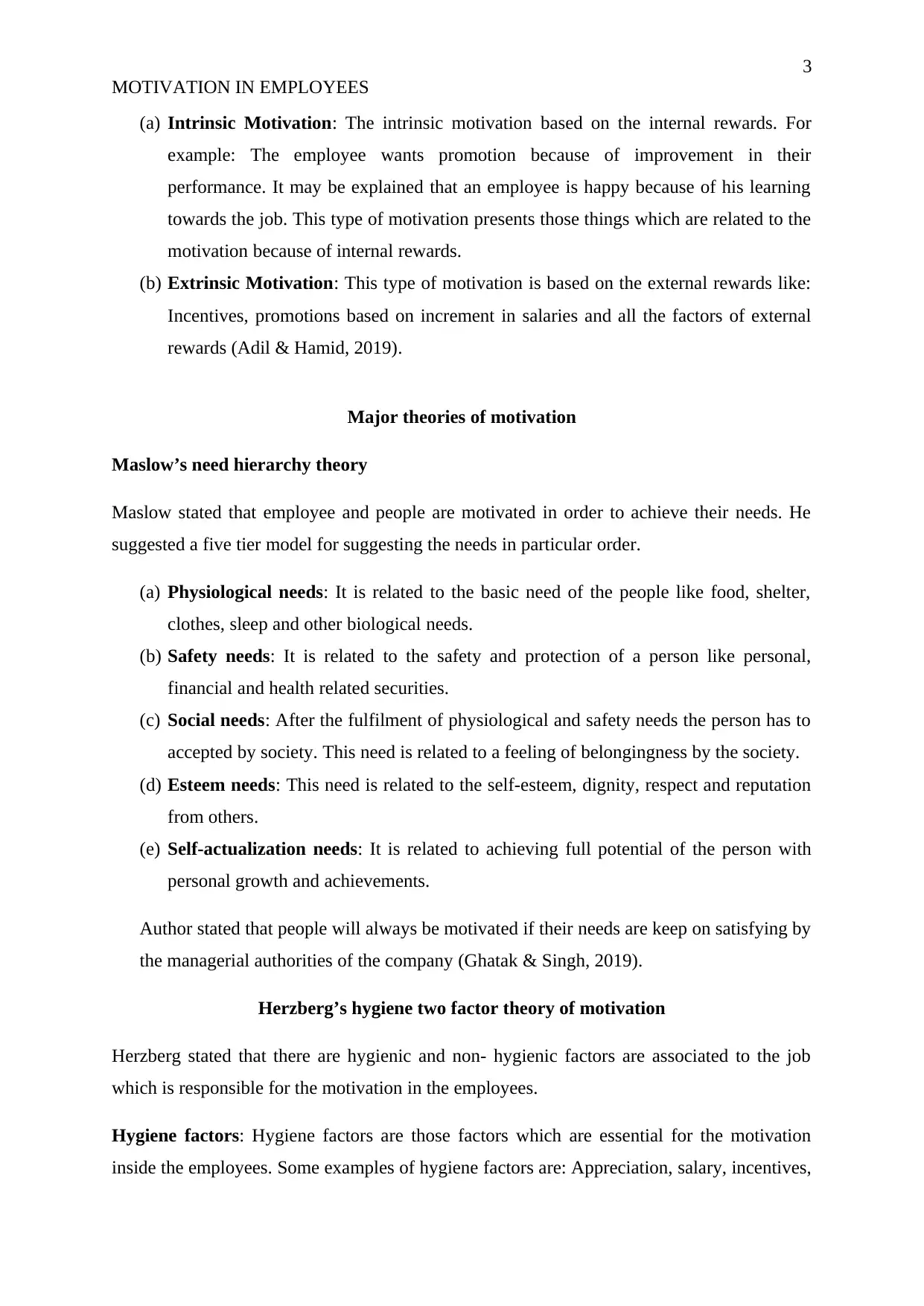
3
MOTIVATION IN EMPLOYEES
(a) Intrinsic Motivation: The intrinsic motivation based on the internal rewards. For
example: The employee wants promotion because of improvement in their
performance. It may be explained that an employee is happy because of his learning
towards the job. This type of motivation presents those things which are related to the
motivation because of internal rewards.
(b) Extrinsic Motivation: This type of motivation is based on the external rewards like:
Incentives, promotions based on increment in salaries and all the factors of external
rewards (Adil & Hamid, 2019).
Major theories of motivation
Maslow’s need hierarchy theory
Maslow stated that employee and people are motivated in order to achieve their needs. He
suggested a five tier model for suggesting the needs in particular order.
(a) Physiological needs: It is related to the basic need of the people like food, shelter,
clothes, sleep and other biological needs.
(b) Safety needs: It is related to the safety and protection of a person like personal,
financial and health related securities.
(c) Social needs: After the fulfilment of physiological and safety needs the person has to
accepted by society. This need is related to a feeling of belongingness by the society.
(d) Esteem needs: This need is related to the self-esteem, dignity, respect and reputation
from others.
(e) Self-actualization needs: It is related to achieving full potential of the person with
personal growth and achievements.
Author stated that people will always be motivated if their needs are keep on satisfying by
the managerial authorities of the company (Ghatak & Singh, 2019).
Herzberg’s hygiene two factor theory of motivation
Herzberg stated that there are hygienic and non- hygienic factors are associated to the job
which is responsible for the motivation in the employees.
Hygiene factors: Hygiene factors are those factors which are essential for the motivation
inside the employees. Some examples of hygiene factors are: Appreciation, salary, incentives,
MOTIVATION IN EMPLOYEES
(a) Intrinsic Motivation: The intrinsic motivation based on the internal rewards. For
example: The employee wants promotion because of improvement in their
performance. It may be explained that an employee is happy because of his learning
towards the job. This type of motivation presents those things which are related to the
motivation because of internal rewards.
(b) Extrinsic Motivation: This type of motivation is based on the external rewards like:
Incentives, promotions based on increment in salaries and all the factors of external
rewards (Adil & Hamid, 2019).
Major theories of motivation
Maslow’s need hierarchy theory
Maslow stated that employee and people are motivated in order to achieve their needs. He
suggested a five tier model for suggesting the needs in particular order.
(a) Physiological needs: It is related to the basic need of the people like food, shelter,
clothes, sleep and other biological needs.
(b) Safety needs: It is related to the safety and protection of a person like personal,
financial and health related securities.
(c) Social needs: After the fulfilment of physiological and safety needs the person has to
accepted by society. This need is related to a feeling of belongingness by the society.
(d) Esteem needs: This need is related to the self-esteem, dignity, respect and reputation
from others.
(e) Self-actualization needs: It is related to achieving full potential of the person with
personal growth and achievements.
Author stated that people will always be motivated if their needs are keep on satisfying by
the managerial authorities of the company (Ghatak & Singh, 2019).
Herzberg’s hygiene two factor theory of motivation
Herzberg stated that there are hygienic and non- hygienic factors are associated to the job
which is responsible for the motivation in the employees.
Hygiene factors: Hygiene factors are those factors which are essential for the motivation
inside the employees. Some examples of hygiene factors are: Appreciation, salary, incentives,
Paraphrase This Document
Need a fresh take? Get an instant paraphrase of this document with our AI Paraphraser
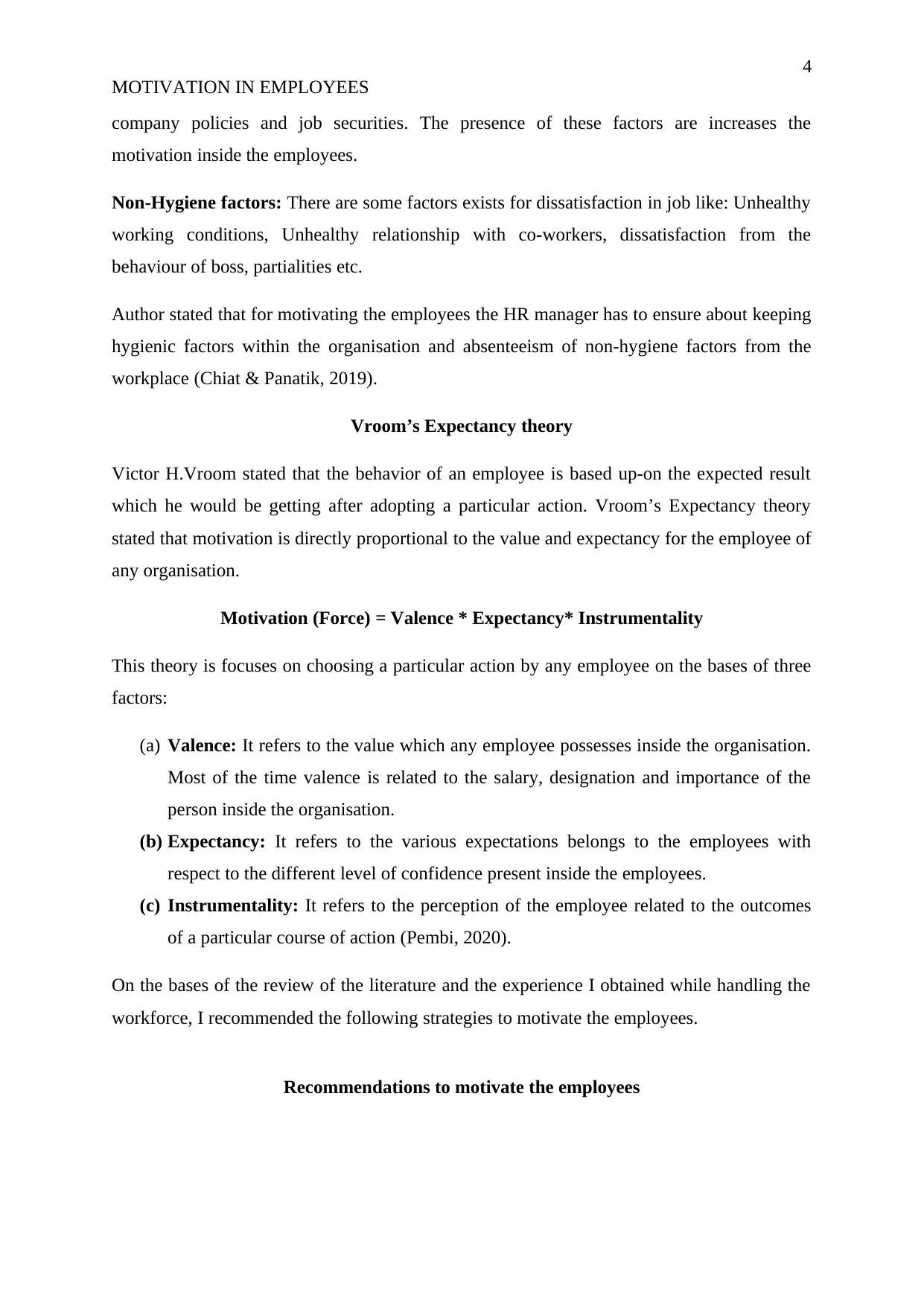
4
MOTIVATION IN EMPLOYEES
company policies and job securities. The presence of these factors are increases the
motivation inside the employees.
Non-Hygiene factors: There are some factors exists for dissatisfaction in job like: Unhealthy
working conditions, Unhealthy relationship with co-workers, dissatisfaction from the
behaviour of boss, partialities etc.
Author stated that for motivating the employees the HR manager has to ensure about keeping
hygienic factors within the organisation and absenteeism of non-hygiene factors from the
workplace (Chiat & Panatik, 2019).
Vroom’s Expectancy theory
Victor H.Vroom stated that the behavior of an employee is based up-on the expected result
which he would be getting after adopting a particular action. Vroom’s Expectancy theory
stated that motivation is directly proportional to the value and expectancy for the employee of
any organisation.
Motivation (Force) = Valence * Expectancy* Instrumentality
This theory is focuses on choosing a particular action by any employee on the bases of three
factors:
(a) Valence: It refers to the value which any employee possesses inside the organisation.
Most of the time valence is related to the salary, designation and importance of the
person inside the organisation.
(b) Expectancy: It refers to the various expectations belongs to the employees with
respect to the different level of confidence present inside the employees.
(c) Instrumentality: It refers to the perception of the employee related to the outcomes
of a particular course of action (Pembi, 2020).
On the bases of the review of the literature and the experience I obtained while handling the
workforce, I recommended the following strategies to motivate the employees.
Recommendations to motivate the employees
MOTIVATION IN EMPLOYEES
company policies and job securities. The presence of these factors are increases the
motivation inside the employees.
Non-Hygiene factors: There are some factors exists for dissatisfaction in job like: Unhealthy
working conditions, Unhealthy relationship with co-workers, dissatisfaction from the
behaviour of boss, partialities etc.
Author stated that for motivating the employees the HR manager has to ensure about keeping
hygienic factors within the organisation and absenteeism of non-hygiene factors from the
workplace (Chiat & Panatik, 2019).
Vroom’s Expectancy theory
Victor H.Vroom stated that the behavior of an employee is based up-on the expected result
which he would be getting after adopting a particular action. Vroom’s Expectancy theory
stated that motivation is directly proportional to the value and expectancy for the employee of
any organisation.
Motivation (Force) = Valence * Expectancy* Instrumentality
This theory is focuses on choosing a particular action by any employee on the bases of three
factors:
(a) Valence: It refers to the value which any employee possesses inside the organisation.
Most of the time valence is related to the salary, designation and importance of the
person inside the organisation.
(b) Expectancy: It refers to the various expectations belongs to the employees with
respect to the different level of confidence present inside the employees.
(c) Instrumentality: It refers to the perception of the employee related to the outcomes
of a particular course of action (Pembi, 2020).
On the bases of the review of the literature and the experience I obtained while handling the
workforce, I recommended the following strategies to motivate the employees.
Recommendations to motivate the employees
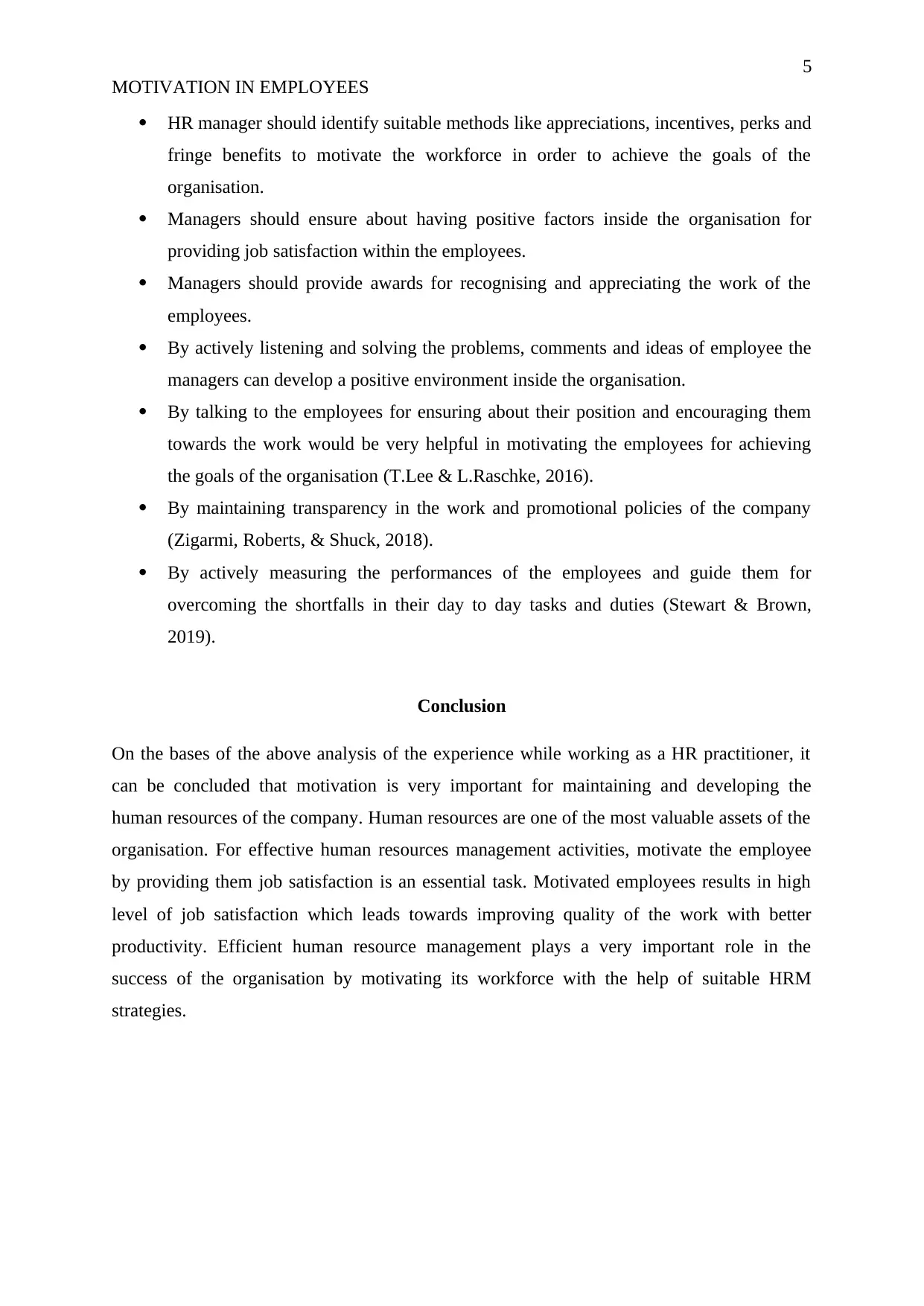
5
MOTIVATION IN EMPLOYEES
HR manager should identify suitable methods like appreciations, incentives, perks and
fringe benefits to motivate the workforce in order to achieve the goals of the
organisation.
Managers should ensure about having positive factors inside the organisation for
providing job satisfaction within the employees.
Managers should provide awards for recognising and appreciating the work of the
employees.
By actively listening and solving the problems, comments and ideas of employee the
managers can develop a positive environment inside the organisation.
By talking to the employees for ensuring about their position and encouraging them
towards the work would be very helpful in motivating the employees for achieving
the goals of the organisation (T.Lee & L.Raschke, 2016).
By maintaining transparency in the work and promotional policies of the company
(Zigarmi, Roberts, & Shuck, 2018).
By actively measuring the performances of the employees and guide them for
overcoming the shortfalls in their day to day tasks and duties (Stewart & Brown,
2019).
Conclusion
On the bases of the above analysis of the experience while working as a HR practitioner, it
can be concluded that motivation is very important for maintaining and developing the
human resources of the company. Human resources are one of the most valuable assets of the
organisation. For effective human resources management activities, motivate the employee
by providing them job satisfaction is an essential task. Motivated employees results in high
level of job satisfaction which leads towards improving quality of the work with better
productivity. Efficient human resource management plays a very important role in the
success of the organisation by motivating its workforce with the help of suitable HRM
strategies.
MOTIVATION IN EMPLOYEES
HR manager should identify suitable methods like appreciations, incentives, perks and
fringe benefits to motivate the workforce in order to achieve the goals of the
organisation.
Managers should ensure about having positive factors inside the organisation for
providing job satisfaction within the employees.
Managers should provide awards for recognising and appreciating the work of the
employees.
By actively listening and solving the problems, comments and ideas of employee the
managers can develop a positive environment inside the organisation.
By talking to the employees for ensuring about their position and encouraging them
towards the work would be very helpful in motivating the employees for achieving
the goals of the organisation (T.Lee & L.Raschke, 2016).
By maintaining transparency in the work and promotional policies of the company
(Zigarmi, Roberts, & Shuck, 2018).
By actively measuring the performances of the employees and guide them for
overcoming the shortfalls in their day to day tasks and duties (Stewart & Brown,
2019).
Conclusion
On the bases of the above analysis of the experience while working as a HR practitioner, it
can be concluded that motivation is very important for maintaining and developing the
human resources of the company. Human resources are one of the most valuable assets of the
organisation. For effective human resources management activities, motivate the employee
by providing them job satisfaction is an essential task. Motivated employees results in high
level of job satisfaction which leads towards improving quality of the work with better
productivity. Efficient human resource management plays a very important role in the
success of the organisation by motivating its workforce with the help of suitable HRM
strategies.
⊘ This is a preview!⊘
Do you want full access?
Subscribe today to unlock all pages.

Trusted by 1+ million students worldwide
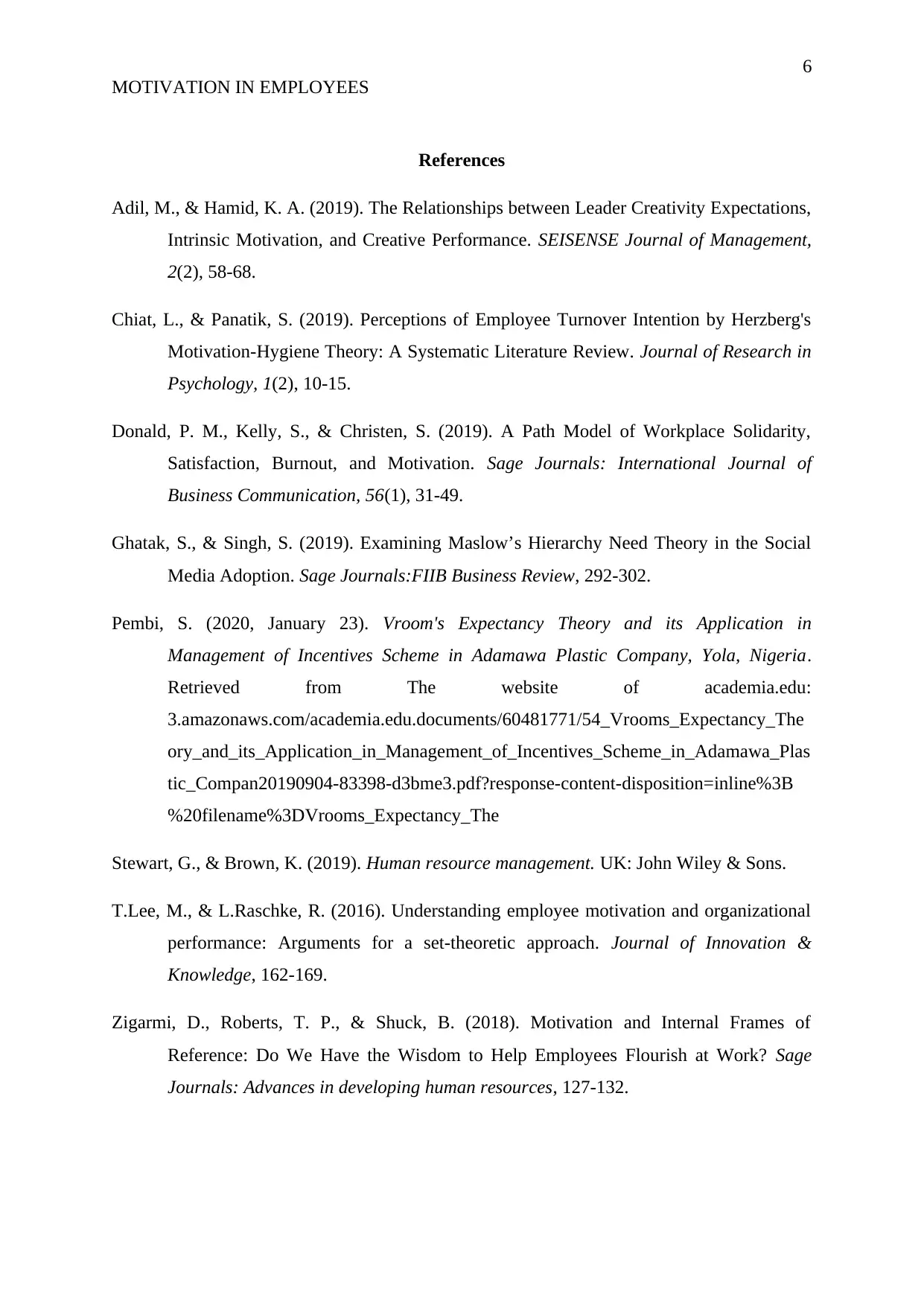
6
MOTIVATION IN EMPLOYEES
References
Adil, M., & Hamid, K. A. (2019). The Relationships between Leader Creativity Expectations,
Intrinsic Motivation, and Creative Performance. SEISENSE Journal of Management,
2(2), 58-68.
Chiat, L., & Panatik, S. (2019). Perceptions of Employee Turnover Intention by Herzberg's
Motivation-Hygiene Theory: A Systematic Literature Review. Journal of Research in
Psychology, 1(2), 10-15.
Donald, P. M., Kelly, S., & Christen, S. (2019). A Path Model of Workplace Solidarity,
Satisfaction, Burnout, and Motivation. Sage Journals: International Journal of
Business Communication, 56(1), 31-49.
Ghatak, S., & Singh, S. (2019). Examining Maslow’s Hierarchy Need Theory in the Social
Media Adoption. Sage Journals:FIIB Business Review, 292-302.
Pembi, S. (2020, January 23). Vroom's Expectancy Theory and its Application in
Management of Incentives Scheme in Adamawa Plastic Company, Yola, Nigeria.
Retrieved from The website of academia.edu:
3.amazonaws.com/academia.edu.documents/60481771/54_Vrooms_Expectancy_The
ory_and_its_Application_in_Management_of_Incentives_Scheme_in_Adamawa_Plas
tic_Compan20190904-83398-d3bme3.pdf?response-content-disposition=inline%3B
%20filename%3DVrooms_Expectancy_The
Stewart, G., & Brown, K. (2019). Human resource management. UK: John Wiley & Sons.
T.Lee, M., & L.Raschke, R. (2016). Understanding employee motivation and organizational
performance: Arguments for a set-theoretic approach. Journal of Innovation &
Knowledge, 162-169.
Zigarmi, D., Roberts, T. P., & Shuck, B. (2018). Motivation and Internal Frames of
Reference: Do We Have the Wisdom to Help Employees Flourish at Work? Sage
Journals: Advances in developing human resources, 127-132.
MOTIVATION IN EMPLOYEES
References
Adil, M., & Hamid, K. A. (2019). The Relationships between Leader Creativity Expectations,
Intrinsic Motivation, and Creative Performance. SEISENSE Journal of Management,
2(2), 58-68.
Chiat, L., & Panatik, S. (2019). Perceptions of Employee Turnover Intention by Herzberg's
Motivation-Hygiene Theory: A Systematic Literature Review. Journal of Research in
Psychology, 1(2), 10-15.
Donald, P. M., Kelly, S., & Christen, S. (2019). A Path Model of Workplace Solidarity,
Satisfaction, Burnout, and Motivation. Sage Journals: International Journal of
Business Communication, 56(1), 31-49.
Ghatak, S., & Singh, S. (2019). Examining Maslow’s Hierarchy Need Theory in the Social
Media Adoption. Sage Journals:FIIB Business Review, 292-302.
Pembi, S. (2020, January 23). Vroom's Expectancy Theory and its Application in
Management of Incentives Scheme in Adamawa Plastic Company, Yola, Nigeria.
Retrieved from The website of academia.edu:
3.amazonaws.com/academia.edu.documents/60481771/54_Vrooms_Expectancy_The
ory_and_its_Application_in_Management_of_Incentives_Scheme_in_Adamawa_Plas
tic_Compan20190904-83398-d3bme3.pdf?response-content-disposition=inline%3B
%20filename%3DVrooms_Expectancy_The
Stewart, G., & Brown, K. (2019). Human resource management. UK: John Wiley & Sons.
T.Lee, M., & L.Raschke, R. (2016). Understanding employee motivation and organizational
performance: Arguments for a set-theoretic approach. Journal of Innovation &
Knowledge, 162-169.
Zigarmi, D., Roberts, T. P., & Shuck, B. (2018). Motivation and Internal Frames of
Reference: Do We Have the Wisdom to Help Employees Flourish at Work? Sage
Journals: Advances in developing human resources, 127-132.
Paraphrase This Document
Need a fresh take? Get an instant paraphrase of this document with our AI Paraphraser
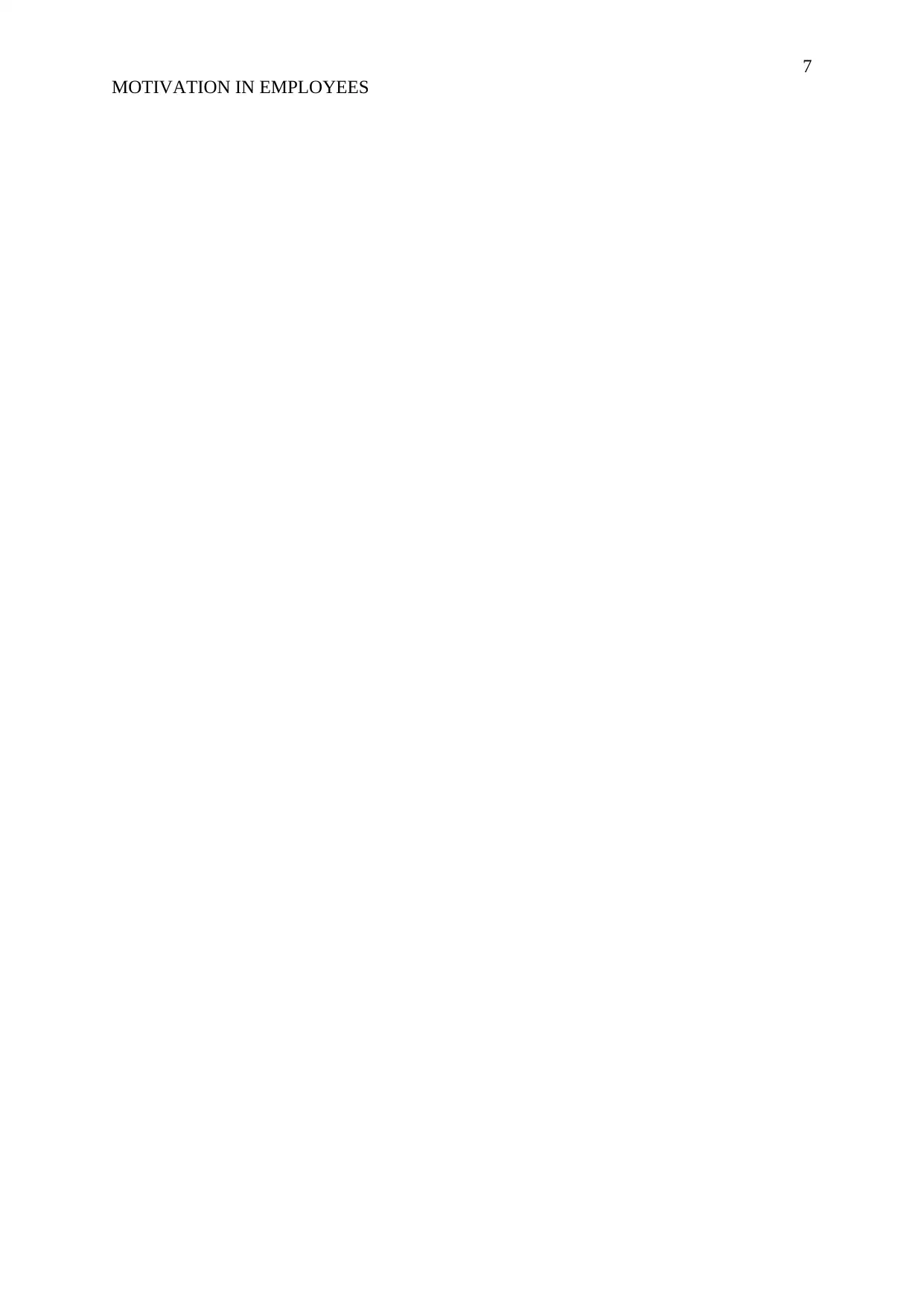
7
MOTIVATION IN EMPLOYEES
MOTIVATION IN EMPLOYEES
1 out of 8
Related Documents
Your All-in-One AI-Powered Toolkit for Academic Success.
+13062052269
info@desklib.com
Available 24*7 on WhatsApp / Email
![[object Object]](/_next/static/media/star-bottom.7253800d.svg)
Unlock your academic potential
Copyright © 2020–2025 A2Z Services. All Rights Reserved. Developed and managed by ZUCOL.



